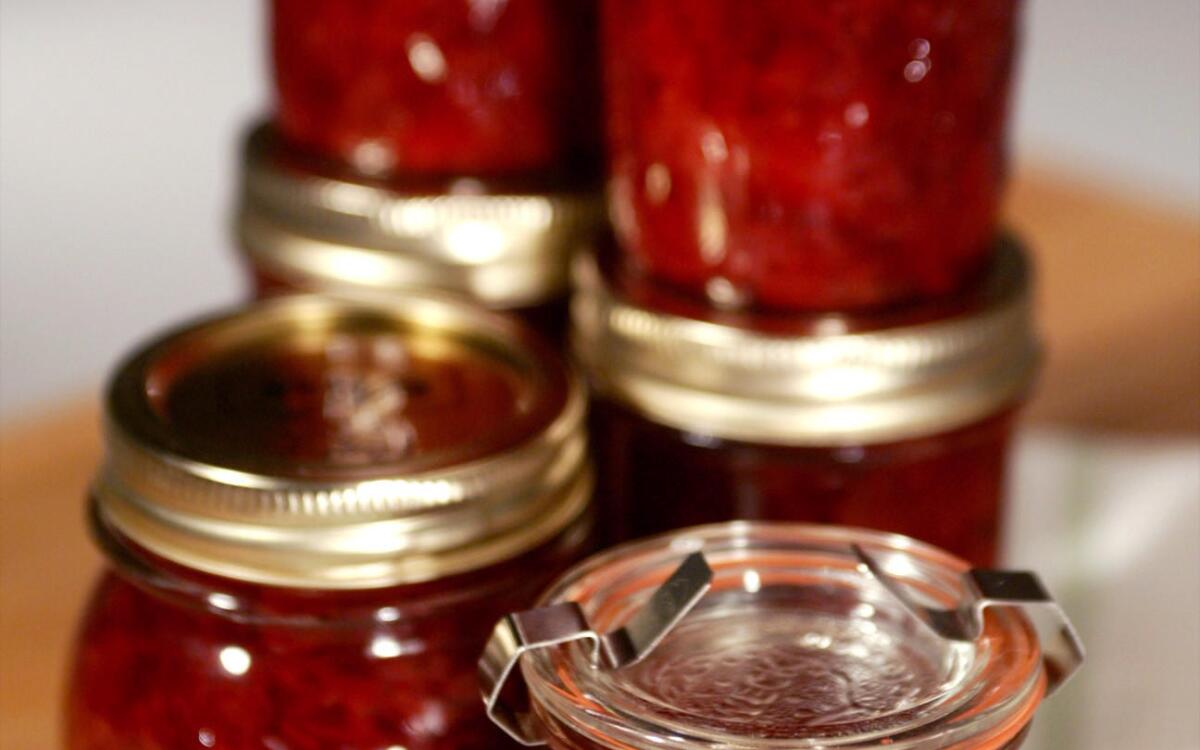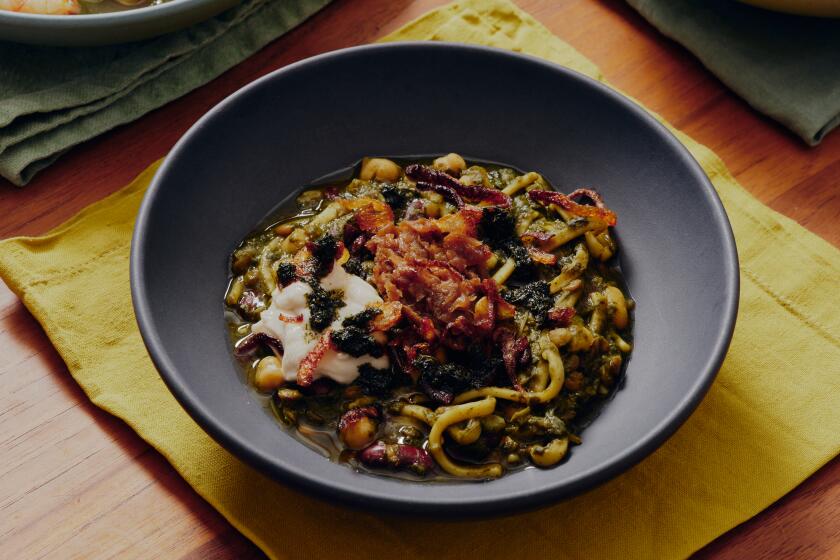Slow-cooked strawberry preserves

Strawberries don’t wait for you to find them. They beckon. Their botanical name, Fragaria, means fragrance, and it’s their sudden perfume in farmers markets, stall after stall, that signals the start of a new fruit season in Los Angeles. From April through June, they’re at their sweetest, with that unique combination of firmness, seedy interest and intense rush of juice.
One has to study the plant’s caning habit in the ground to appreciate its standing as a member of the rose family. Like the flowers, they’ve been bred to emphasize the qualities we relish. The berry we eat is the result of a marriage of two American species, Chilean and Virginian, which for obvious geographical reasons never hybridized in the wild, but which met in an 18th-century French garden and were artfully crossed for the table.
The Virginian brought flavor and color, the Chilean size. As hundreds of commercial cultivars have been developed around the world, breeders still struggle to find the right balance between the two. The bigger a strawberry gets, the more careful one should be checking for flavor before paying $3 a pint. Too often the flavor is on the surface, with the red skin and carpet of often yellow seeds, while the bulk of the berry itself is white and tasteless.
A really good strawberry will be red almost to the center and highly perfumed, and -- don’t laugh -- will taste of pineapple, except without the violence of that tropical fruit’s pitched sugars and acids. The French were so struck by the similarity, they named the table strawberry Fragaria x ananassa, ananassa meaning pineapple.
Since that original French masterstroke of dessert-making in the garden, any number of “fragrant pineapple” cultivars have been developed, dozens in California, where most American strawberries are grown. A progressive season starts in San Diego and moves up the state to Watsonville and Salinas. Right now, our strawberries are from up the coast in Oxnard.
To appreciate how lucky we are in Los Angeles, it’s useful to compare supermarket strawberries with farmers market ones. The supermarket ones probably will be one of the leading commercial varieties, Camarosa or Diamonte, picked young, chilled and suffocated in plastic. Although you can get good Camarosas, usually at farmers markets, it’s a sporting proposition and odds are that you’ll fail.
By contrast, walk through Santa Monica or Hollywood farmers markets, and just-picked flats of ripe, red berries will be Gaviota, Seascape and that jam-on-vine variety, Chandlers -- three cultivars grown in such small quantities that the California Strawberry Commission doesn’t even have statistics for their market share. These are the berries largely abandoned by commercial growers because they don’t ship well. They’re kept alive by specialist growers and home gardeners because of their superb flavor.
Breakfast, lunch and dinner
The most frustrating thing about buying strawberries in supermarkets, aside from not being able to taste them, is that commercial vendors don’t label varieties. The strawberry commission says the exercise would be onerous, what with the variables faced by packers and suppliers. Poor packers. Poor supermarkets. Imagine serving customers who actually want to know what they’re eating. The commission urges anyone who encounters a disappointing strawberry to let them know. They really, really want our opinion, they say. (Here’s where to gripe: www.calstrawberry.com/.)
But not right now. Right now we face the burden of living in the early season corridor of the strawberry capital of America. Our problem is how to keep up with plenty, not letting a single farmers-market berry miss its rightful fate of being devoured. The most obvious solution is Miss Piggy’s. Eat as many as you can carry.
The stall keeper at one of my regular providers, Harry’s Berries, assures me that I am not the only person who arrives at their stall every Saturday morning and buys a case -- for myself. A pint might go to a neighbor. But the rest is spoken for. You never hear of people getting fat because they ate too much fruit. During season, breakfast is strawberries with Straus organic yogurt and honey (only Straus, accept no substitutes). Lunch is an omelet and asparagus, maybe, then more strawberries. Dinner is salad with goat’s cheese and more strawberries. The late night snack is more strawberries, until the minty pall of toothpaste forces a curfew on strawberry consumption.
In the 1980s, it was fashionable to cook with strawberries. A pillar of English catering, Prue Leith, created what might have been the ultimate ‘80s salad: fanned avocado with strawberries and a mustardy vinaigrette. French chefs put the strawberries straight into vinegars and deglazed chicken liver pans with them. Also excellent, and very ‘80s. The cookery writer Jane Grigson promoted two piquant and simple garnishes: grated lemon zest and/or black pepper.
My dear friend and recipe oracle, the London chef and writer Jeremy Lee, once took an English boarding school dish of smashed meringues, strawberries and cream called “Eton mess” and actually wrote it into a recipe in his debut column in the Guardian newspaper. At the time, I berated him for what is to a casual observer a road-kill Pavlova. But when I got around to trying the recipe, it was heavenly. The meringues dissolve, becoming suspended in the cream, where they act as a subtle sweetener, gently accenting the berry.
The best strawberry cook I’ve ever met is Edon Waycott, former jam maker to Campanile restaurant. Waycott made other jams, but her genius was with strawberries. Typical jam recipes, especially fast ones, call for one part sugar to two parts fruit, with the sugar acting as the setting agent. The sweetness too often upstages the strawberry. By contrast, Waycott used one part sugar to six parts fruit. By macerating the fruit overnight, then cooking it for a long time, slowly and gently in a broad, shallow pan, the berries retained their form and flavor, and came out tasting more like themselves than themselves -- like strawberries squared, rather than, as she called it, “merely red.” Several years ago, she gave us her recipe, but somehow when it was published a four-hour jam became a one-hour jam.
Layers of storage
Last summer, Waycott phoned to say she was retiring -- something about devoting more time to her family, horses and garden. I did the sensible thing and bought one of the last cases of her strawberry jam. Over Christmas, those jars went to my favorite friends. “It’s like a spoonful of France,” said one. One day, there were no more of spoonfuls left in the cupboard. This year, as Santa Monica’s farmers market began to heave with Chandlers and Gaviotas, I bought a big copper pan and proposed we publish the recipe again -- but right this time.
The flavor of those three varieties of strawberries now in the markets can change with weather. Rain or boggy conditions waterlog any berry. However, as a rule, Seascape are a bit tangier, best for dessert recipes such as Jeremy’s Eton Mess and for covering with cream and garnishing with honey. Gaviotas and Chandlers are sweeter, perfect for eating by the handful. For jam, a tart berry such as Seascape can perform wonderfully, but it will need a bit more sugar, three cups for a case instead of two. Sweeter berries, such as Chandlers take two. Gaviotas, two and a half, maybe. The difference in berry variety shows dramatically in the jam. The tarter berries cooked with slightly more sugar result in a brighter flavor, more pronounced contrast between acid and sugar, while the sweeter berries produce a richer fruit. Think of the difference between Beaujolais and aged claret.
Whatever you do with them, the trick with a case a week habit is storage. The packaging strawberries come in, from both stores and farmers markets, leaves them in moist traps that invite rot. This technique for repacking them at home comes from Harry’s Berries. It can prolong the life of a ripe strawberry from a day to a week.
First, get the strawberries home, fast. Or if you can’t, take a cooler with chill packs to the farmers market. Once home, do not rinse the berries before storing. Dampness will enhance rot. I brush and trim obvious crud but never wash them. Others rinse them just before eating. Never submerge.
But before packing, merely pick out and discard any damaged or moldy ones. Get airtight plastic containers; a deep rectangular Tupperware box is perfect. Line the bottom with a paper towel. Cover the bottom with the first pint. Cover them with another layer of paper towel. Cover with another layer of berries. I’ve stored as many as five layers of berries in one large tub. Cover the last layer -- the paper will absorb any excess moisture and keep rot at bay. Then store the berries in the top shelf of the fridge, the coldest one, where they will remain suspended at ripeness, ready to eat and in good order as you unveil and eat each layer.
If you must buy strawberries in supermarkets, remove them from their plastic containers and store them Harry’s way.
The final question: what to drink with them? Champagne, particularly at breakfast.
Brush or lightly rinse the berries without submerging them in water. Remove the hulls, leaving the berries whole. Combine the berries, sugar and juice in a non-aluminum bowl. Allow the berries to macerate at room temperature, stirring occasionally, for at least 3 to 4 hours. The mixture can be covered and refrigerated overnight at this point.
Divide the berries and the juice (it will yield approximately two pints) in equal proportions into 2 or 3 wide, shallow pans -- a large copper-bottomed risotto pan or cast-iron enameled pot is good. If using a thin pan, use a heat diffuser to avoid hot spots. Bring the mixture to a boil over high heat, skim the foam that collects on the surface, then reduce the heat to low. Make sure bubbles continue to break the surface. Stir the mixture gently, pushing the berries in a gentle circle, taking care not to slice through them or break them up. Part of the charm of the jam is the proportion of whole berries.
After about 20 minutes, the berries will give up additional juices and appear to be floating. Press them with a wooden spoon and skim off foam, placing the foam in a bowl near the stove. As the foam juice collects, skim it, and return the red juice to the pan.
Continue cooking the berries, stirring and skimming occasionally for 3 to 4 hours. The cooking time will vary depending on the berries, the amount of sugar, the type of pan and the heat from burners. The jam is almost done when it turns dark red, the ratio of berries to juice is about equal and it begins to coat a wooden spoon. At the end of 3 hours, tart berries cooked with more sugar should be done. It may take closer to 4 hours for berries cooked with the lesser amount of sugar. If necessary, after 4 hours, raise the temperature to quickly cook off excess water, stirring to prevent scorching. To test for how the preserves will set, put a spoonful on a frozen plate and see how it gels. Turn off heat and can in the usual way, or allow to cool and refrigerate and use within several days.
Get our Cooking newsletter.
Your roundup of inspiring recipes and kitchen tricks.
You may occasionally receive promotional content from the Los Angeles Times.















